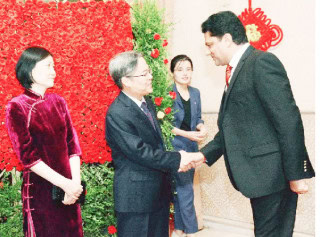ON its 75th National Day celebration, People’s Republic of China showcases an illustration of an outstanding economic evolution in recent times. The country has shifted from being mainly agricultural when established in 1949 to holding the rank of the world’s largest economy due to deliberate reforms and swift industrial growth coupled with a persistent dedication to advancement and innovation. The economic changes started by Deng Xiaoping in 1978 paved the way for decades of progress and unprecedented growth that pushed China from the outskirts of the global economy to its central position today. This transformation has not just reshaped China’s domestic landscape but has also significantly impacted the global economic structure leading to shifts in various sectors and trade dynamics as well as influencing international relationships on a broad scale. Ever since assuming office in 2013, Chinese President Xi Jinping has presided over a reformist administration – one that shared a single-minded goal of uprooting poverty. The Global Development Initiative (GDI), Global Civilization Initiative (GCI) and Global Security Initiative (GSI) constitute the bedrock of President Xi Jinping’s vision of an inclusive and multi-polar world. These initiatives combine reflect China’s rising influence in global governance and commitment to promoting international cooperation and a community with a shared future for humanity. In recent years, China has reached several important milestones that solidify its position as a strong economic force. In 2021, China proudly declared that it had accomplished a “complete victory” over extreme poverty based on national standards, marking a significant global development milestone. Astoundingly, Beijing met the poverty relief goals set by the United Nations’ 2030 Agenda for Sustainable Development a full decade early. In modern history, there has never been an example of achievement on the scale and at the speed undertaken over this vast territory. Through targeted policies, substantial investments, and innovative programs, China lifted over 800 million people out of poverty. This monumental effort not only transformed lives but also set a global benchmark for poverty alleviation. China’s success story is a testament to the power of strategic planning and unwavering commitment.
China’s focus on growth and global expansion revolves around the Belt and Road Initiative (BRI) which was introduced in 2013 by President Xi Jinping as a move for enhancing international connectivity and collaboration worldwide. The BRI has transformed into a network of initiatives involving infrastructure development as well as trade and cultural engagements across regions in Asia, Europe, Africa and other parts of the world. The sheer magnitude of the BRI initiative is unparalleled with investments and construction deals surpassing $1 trillion by the year 2023. This significant effort now spans more than 150 countries, representing around 60 percent of the global population and 40 percent of the world’s GDP. The BRI has supported the development of infrastructure in the countries involved; this includes building fast train systems in Southeast Asia and constructing ports in Africa well as energy ventures, in Central Asia. The expansive endeavors highlight the breadth and drive of the initiative; the China Laos railway, a $6 billion project has notably shortened travel time. The $1. 3 Billion enhancement of the Port of Piraeus in Greece has turned it into one of Europe’s premier ports, and the ambitious $62 billion China Pakistan Economic Corridor (CPEC) is poised to transform Pakistan’s infrastructure and energy landscape.

The trade industry has seen changes due to the increase in China Europe freight train journeys exceeding 17 thousand by 2023 and enabling the trade of goods valued at more than $300 billion. This enhanced connectivity has not only expanded opportunities for products and services in new markets but also granted partner nations better access to the extensive Chinese consumer market. The BRI has channeled substantial Chinese investments into developing economies, supporting local industries, creating jobs, and stimulating economic growth. The establishment of the Asian Infrastructure Investment Bank (AIIB), under the BRI, has positioned China as a player in development financing and solidified its influence on international economic frameworks. In addition to its economic impact, the BRI has promoted cultural interactions that have strengthened relationships between China and other countries by fostering a sense of unity among people. This cultural exchange element has played a role in enhancing China’s reputation on the world stage and nurturing enduring partnerships with its allies. Expanding on the Belt and Road Initiative (BRI), the Digital Silk Road project seeks to boost connectivity by encouraging shopping platforms and digital money services within the BRI network through investments surpassing $50 billion across various ventures like G5 networks and urban development schemes. This digital dimension has become a crucial game changer in the post pandemic era that spurs technological fusion and digital financial advancement among member countries.
China has promised to implement a ‘green’ and ‘clean’ BRI — vowing to ban all new coal-fired power projects overseas and boost investment in renewable energy initiatives. China aims to promote high-quality development and technology self-reliance as mentioned in the 14th Five-Year Plan (2021-2025). The plan outlines various ambitious targets, such as year-on-year growth of over 7% in R&D expenditure and lifting the contribution of the digital economy to GDP to 70% by 2025. The future of BRI projects will seemingly correlate more with sustainable development goals and China has announced investments worth $100bn in green energy projects over the next ten years. The move is part of China’s overarching initiative to achieve carbon neutrality by 2060, a feat that is expected to require well in excess of $15 trillion invested into green technologies and infrastructure. Moreover, China has made strides in its space exploration endeavors with missions to the Moon and Mars that showcase its technological prowess worldwide. China has consistently demonstrated a remarkable ability to navigate enormous challenges and capitalize on opportunities – and we should expect that economic vibrancy and global clout over the remainder of this century. And with the eyes of the world on China, another is unquestionable – the economy of China and its mix of ambitious efforts like Belt and Road as well as devotion to homegrown self-reliance will be among (if not) a pivotal defining narrative of our era.










